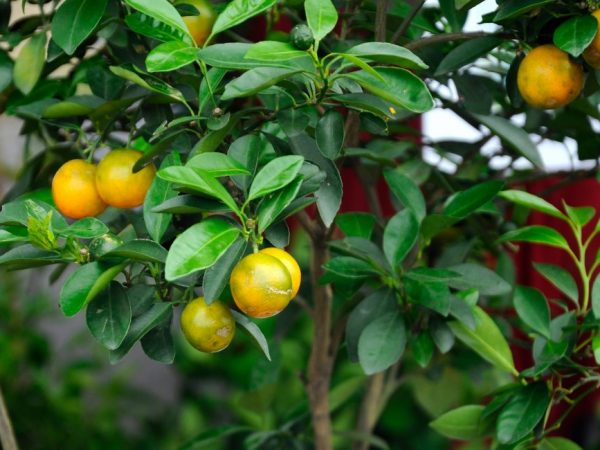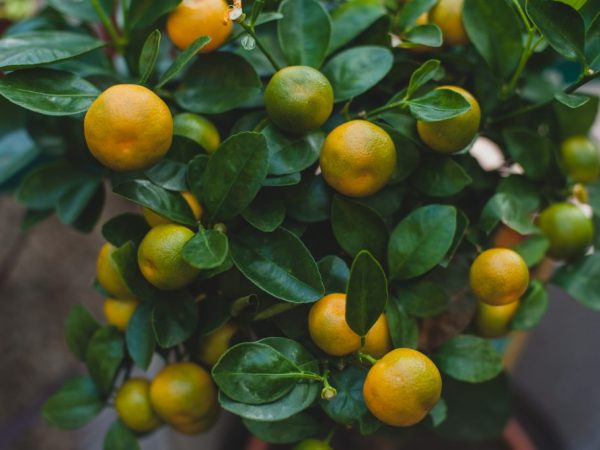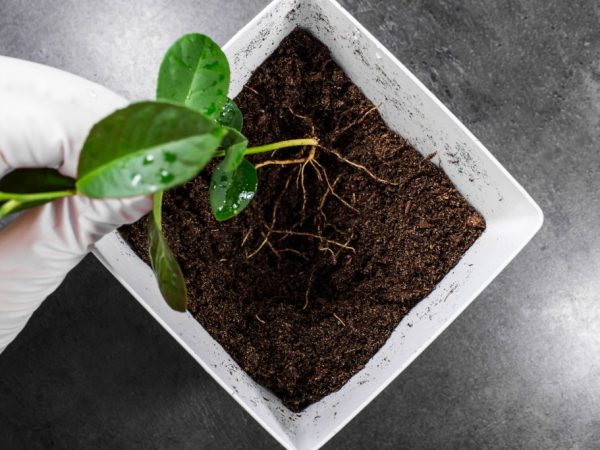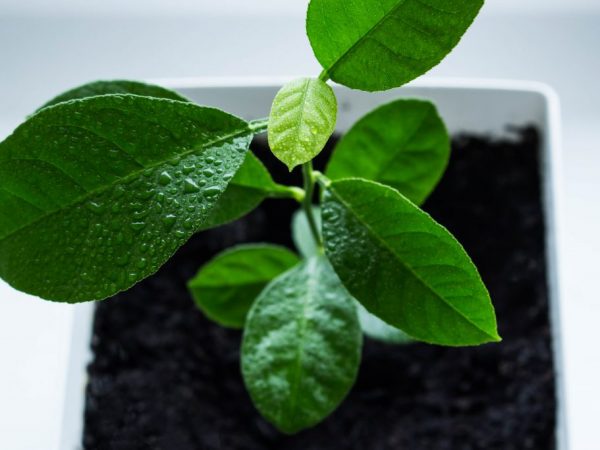Caring for calamondin at home
Citrofortunella, or Calamondin, is a small citrus tree native to Asia. In our area, it is grown in greenhouses, greenhouses or apartments. The plant blooms and bears fruit indoors. Caring for calamondin at home is simple: the view is not demanding.
- General information and varieties
- Calamondin varieties
- Calamondin care rules
- Lighting
- Temperature
- Watering and irrigation
- Top dressing
- Transplant and pruning
- Transfer
- Pruning
- Reproduction
- Propagation by bones
- Propagation by cuttings
- Propagation by air layers
- Care problems
- Diseases and pests of citrofortunella
- Diseases
- Pests

Caring for calamondin at home
General information and varieties
An indoor plant of the calamondin species is native to Asia. It belongs to the Rutov family, the genus Citrus. It is a hybrid. The ancestors of calamnodin are mandarin and kumquat (fortunella). It is sometimes called citrus floridana or citrofortunella. In nature, the tree grows more than 5 m, at home - up to 1-1.5 m. The root system is developed, branched, the roots are covered with a rough brown bark.
The tree begins to branch from the root collar itself, thorns grow on the branches. Almost from the very base of the trunk, the bush is covered with leaves. They are glossy, dark green in color, sitting on short, dense petioles. Their shape is oval or ovoid, a leaf plate is bent along the middle vein, its length is 4-7 cm. There are varieties with variegated leaves. The crown is domed, it lends itself well to shaping.
The flower resembles a white star with five petals 1.5-2 cm in diameter. In the center there is a pistil with a loose top, around 15-20 stamens. When they bloom, they give off a pleasant citrus scent.
Citrofortunella is a self-pollinating species, therefore fruiting occurs regardless of whether manual pollination is carried out or not. Flowering begins in the spring and continues throughout the year. Flowers and fruits on the same tree can be seen at the same time.
Calamondin has a fruit similar to tangerines. They are slightly flattened at the poles, but are elongated or pear-shaped. The rind is green at first, then turns orange, easily separates from the pulp, sweet in taste. The fruits are edible, but sour and bitter. Diameter - 4-5 cm, weight -10-30 g. Jams are made from fruits, added to tea and other dishes.
Calamondin varieties
To date, many varieties of citrofortunella have been bred. Almost any calamondin blooms and bears fruit at home.
Here are the most popular varieties:
- Margarita Nagami. Small-sized frost-resistant variety. Flowering begins in summer, the harvest ripens in late winter The fruits are small, with lemon sourness, the peel tastes like orange or orange.
- Margarita Big. The fruits are large, pear-shaped, sweet and sour.
- Obovata Fukushi. A productive variety with large fruits (up to 5 cm in diameter). The peel is thin, the flesh is sour, with a pleasant aroma, there are bones inside. The crown is round and symmetrical, branches without thorns.
- Meiva. Sweet citrofortunella without bitterness. The fruits are oval or round, orange and medium in size. There are no bones inside. Branches without thorns, the crown is easily formed.The variety is suitable for fresh fruit consumption.
- Variegated or variegated Centeniel cultivar. It got its name due to the specific color of the leaves and green fruits. Tangerines resemble tiny watermelons when ripe. The fruits are juicy, with a thin skin.
- Doll. A hybrid with clementine, it is distinguished by a dense crown and abundant flowering. The fruits are small, pear-shaped. The taste is sour, the peel is edible and sweet.
- Tiger. The leaves of this variety have a thin gold border around the edge. The fruits resemble ordinary tangerines in shape, the taste is sweet and sour.
- Peters. This variety has a beautiful flowering, but tasteless fruits, therefore it is more often planted as an ornamental plant.
When choosing a variety, they check the quality of the fruit and the type of an adult tree. If you buy a plant for harvest, the sweet citrofortunella Meiva is preferred. The decorative appearance is better in the variegated variety. Margarita is the easiest to find in stores. The calamondin tree of this variety is unpretentious in care.
Calamondin care rules

Top dressing will accelerate fruiting
Caring for calamondin at home is not difficult. The main thing is to properly water the plant, to provide it with a normal temperature, good lighting. Productivity increases when the plant is fed on time.
Lighting
To grow calamondin, you need to find a place for it with good lighting. It is recommended to place the pot on the southeast, east or south windowsill. In the summer at noon, the plant is shaded or removed from a sun-drenched place to avoid burning the leaves. In winter, citrofortunella does not have enough light, therefore, a phytolamp is used as an additional lighting. For the correct formation of the crown, the tree is turned clockwise by 10 ° -15 ° once a week.
Temperature
Citrofortunella is one of the most cold-resistant citrus fruits, but this does not mean that the bush should be exposed to frost. The optimum temperature during flowering and fruiting is 18 ° C-27 ° C. To increase yields, in winter the tree is placed in a cool place with a temperature of about 10 ° C-12 ° C. In summer, the tub is kept on the balcony or outdoor terrace. They make sure that there is no sharp cold snap at night and the bush does not freeze.
Watering and irrigation
Watering calamondin is advised as the soil in the pot dries out. A pallet is placed at the bottom and water is drained from it 15 minutes after watering. If the tree grows in a flowerpot, a small basin is attached from below. Then the water is drained as needed. In winter, watering is reduced to 2-3 times a week to provide rest for the plant.
Room humidity is maintained at 70%. If it falls, the bush is irrigated from a spray bottle or a self-watering humidifier is bought. You can not put the flowerpot next to the batteries: in this place the air is dry, the temperature is high and the soil dries out quickly. Excessive moisture is also harmful to the tree: it becomes susceptible to fungal diseases. So that the water in the tub does not stagnate, drainage from coarse sand or expanded clay is placed on the bottom.
Top dressing
Growing citrus fruit trees in tubs has its own characteristics. No matter how large the pot is, there are still few nutrients in the soil. If you do not apply fertilizer, the crop will be poor and the bush will dry out. It is advised to feed calamondin at home all year round. When active vegetation begins, fertilizer is applied once a week. From the second half of summer until the end of autumn, they feed it once every 2 weeks, in winter - once a month.
Use a special citrus fertilizer. It can be root or foliar. Root dressing is diluted according to the instructions and poured directly into the pot, immediately after watering. Foliar sprayed on the leaves and trunk using a special spray bottle.
Transplant and pruning
The correct cultivation of a citrus tree involves transplanting and pruning. If this is not done, the bush will stop growing, the crown will not form correctly.
Transfer
The first transplant of calamondin is carried out 1-2 weeks after purchase, so that the bush adapts and does not throw off the leaves. If the tree is grown from a stone or cuttings, it is advised to transfer it to a new pot when the growth is about 20-25 cm.The procedure is carried out in early spring or at the end of February.
Transplanting a tree has its own rules:
- The pot is taken with a large diameter of 5-10 cm.
- Pay attention to the position of the root collar in the old tub, sprinkle the trunk with soil in a new place to the same level.
- The earthy clod around the roots is not touched. Saprophytic fungi live on the roots of citrus fruits, which help to absorb nutrients from the soil. If the earth is removed, they will die, and with them the whole tree.
- After transplanting, no fertilizer is applied for a month, since there are still many nutrients in the soil.

It is better to prepare the soil for the plant yourself.
The soil to transplant a tree is bought in a store or made with your own hands. For citrus fruits, the following soil composition is suitable:
- sod land - 2 parts;
- sand - 1 part;
- humus - 1 part.
The soil should not be acidic, therefore it is undesirable to add peat to it. A land where streptocarpus or limonella grows well will do. Drainage from expanded clay or a mixture of sand with fine gravel is placed on the bottom of the pot. Calamondin transplant is carried out annually in the first 3-4 years, then the procedure is repeated every 2-3 years.
Pruning
Calamondin is stamped in February. In the summer, only long branches are shortened, the tops are pinched. It is recommended to prune the bush when its height is more than 25 cm. First, remove the upper skeletal branches, then move on to branches of 2-4 levels, leaving the stem intact. The crown is cut in different ways. The most beautiful shape is a ball, a pyramid, a cone. It is recommended to cut citrofortunella as a bush or as a tree.
Reproduction
Citrus calamondin reproduces well at home:
- from the bone;
- cuttings;
- air layering.
Propagation by bones
It is easy to propagate and grow calamondin from a seed. The seeds are obtained from fruits purchased from the supermarket or purchased from a specialty store. Before planting, seeds are germinated on a wet cloth or in a hydrogel. After a week, they are planted in the ground to a depth of 3-4 cm. A month later, the first shoots appear. The tree begins to bear fruit in 3-4 years, this is the main disadvantage of this method of reproduction.
Growing from a stone does not allow preserving the varietal qualities of the species, therefore the bush is grafted in the second year. This is done in several ways:
- under the bark;
- kidney (budding);
- into cleavage.
The thickness of the rootstock trunk at this point must be at least 6 mm. Inexperienced growers are advised to plant the tree in the cleft. Be sure to make sure that the layers of both branches coincide, otherwise the scion will not take root.
The bush is easy to graft by budding. For this, a bud with a piece of wood is placed under the bark.
Propagation by cuttings
Propagating calamondin by cuttings is a popular and reliable method. Cuttings are carried out at the beginning of summer, along with additional pruning. A healthy branch is selected near the top. Cut a stalk about 10 cm long, with 2-3 buds. It is soaked for 1-2 hours in a rooting stimulator. "Heteroauxin", "Kornevin", "Epin" will do.

Choose a healthy stalk for planting
Then the cutting is transferred to a prepared substrate (citrus soil, sand, peat). Before planting, the substrate must be fried in the oven or disinfected with a solution of potassium permanganate. After planting, the cutting is covered with a plastic bottle.
The temperature in the greenhouse is kept at 25 ° C. Twice a day, the bottle is removed for 15-20 minutes to ventilate the seedling. Rooting takes 3-4 weeks. After that, the cutting is transplanted into a 3-4 liter pot. After a month, any fertilizer for calamondin is applied.
Propagation by air layers
Reproduction by layering is also popular among flower growers.This method is even more successful than conventional cuttings. On an adult tree, choose a long and healthy branch with 3-4 buds. Approximately in the middle, a micro-incision is made in a circle, the bark is carefully removed. All leaves are removed at a distance of 4-5 cm from the cut. This place is wrapped for 2-3 hours with a wet cloth with a rooting stimulator to force the root system to develop faster.
Then bend the branch to the ground and sprinkle 2-3 cm of soil. Watered with mineral fertilizer and wait 3-4 weeks. During this time, the branch takes root and is separated from the mother plant. The stalk is transplanted into a new container. Sometimes it is covered with a plastic bottle for a week, creating a mini-greenhouse. Calamondin, grown from a cuttings, bears fruit already in the second year. It completely retains varietal qualities and does not require grafting.
Care problems
Improper home care for calamondin causes a number of problems. The plant becomes weaker, more capricious, more sensitive to damage by fungi and insects. If you identify them in time, correct the oversights, the plant is easy to save. Problems that arise if you take care of the plant incorrectly:
- Calamondin drops all the leaves. There are several reasons for this phenomenon: high temperature in the room, draft, overflow, use of cold water for irrigation. Sometimes leaf fall begins when the tree is transferred to a new place, adaptation lasts up to 2 months. To solve the problem, regulate watering, temperature and humidity in the room. If ineffective, the bush is transplanted.
- Calamondin leaves turn yellow and fall off. This phenomenon is observed with a lack of magnesium in the soil. So that the bush does not throw off the leaves, fertilizers are applied.
- Calamondin does not bloom. Citrofortunella stops blooming if the soil lacks nutrients, in poor lighting, inappropriate soil, in a cramped pot, with frequent changes of location. Flowering stops if the bush is sick or is attacked by pests.
- The fruits are falling. The reason is lack of nutrients. During the period when citrofortunella bears fruit, it must be fed.
- The leaves first sank, then curled and dry. Sign of underfilling, high temperature and dry indoor air.
Proper cultivation, adherence to all care rules prevents all of the above problems. If necessary, the bush should be transplanted, examining whether the roots have rotted. If the correction of errors does not work, most likely the tree has a more serious pathology or pests attacked it.
Diseases and pests of citrofortunella
Often, calamondin is destroyed by diseases and pests. It is possible to reanimate the plant if the infection is detected in time and measures are taken to eliminate it.
Diseases
Most citrofortunella diseases are caused by fungi. They reproduce well in high humidity. Some people like high temperatures, others prefer cold. The most common fungal diseases are:
- Sooty fungus. Leaves, cuttings and shoots are covered with black dots. Flowering branches and fruits do not turn black.
- Anthracosis. With this fungal disease, yellow-brown small spots appear on the leaves, which gradually darken and merge. At the end, the calamondin drops the leaves. The plant begins to ache during the flowering period, before the appearance of the ovary.
- Hommoz. The fungus begins to attack the tree from the roots. Then it spreads to the entire trunk, coarse areas, cracks, gum smudges appear on the bark. The leaves turn yellow and fall off, brown spots are visible on the fruits, tangerines also fall off.
To get rid of the fungus, the bush is treated with fungicides, copper sulfate, Bordeaux liquid. When resuscitation is complete, regulate watering and maintain a normal room temperature. It is advisable to disinfect and ventilate the room well. The diseased parts of the plant are recommended to be cut off and burned.
Pests
Small bugs and worms often harm home plants, calamondin is no exception. Most often, this type of citrus is striking:
- False shields. These are gray-brown insects 1.5-2.5 mm long, the larvae are covered with a kind of shield on top. They live on trunks and branches in colonies, they camouflage well, spoil the bark, which leads to a decrease in yield and death of the plant.
- Spider mite. Lives on the lower part of the leaf plate, covered with a thin cobweb, sucks juice from the plant. From above on the leaf, small white dots are visible, and over time - brown dots. At the end, the leaves curl and fall off.
- Shield. A tiny insect parasitizes on the bark, disguises itself with a shield.
- Whitefly. A small winged insect, its larvae feed on plant sap. They leave a sweet mucus on the leaves - a good substrate for mushrooms.
- Aphid. Large insects, up to 3 mm in length. They feed on the juice of leaves and stems, and carry viral diseases.
It is recommended to fight pests in an apartment using environmentally friendly methods. Insects that have appeared on the tree and the surface of the leaves are collected by hand, washed parts of the bush with soap or alcohol solution, and sprayed with tobacco infusion. In extreme cases, insecticides are used. Pollination is carried out in a mask, then the room is well ventilated.
You do not need experience or special knowledge to buy or plant citrofrtunella. Before starting this tropical plant at home, you should carefully study the rules of care, the main diseases and pests of calamondin. Then the bush will grow healthy, please the eye and give a rich harvest.


